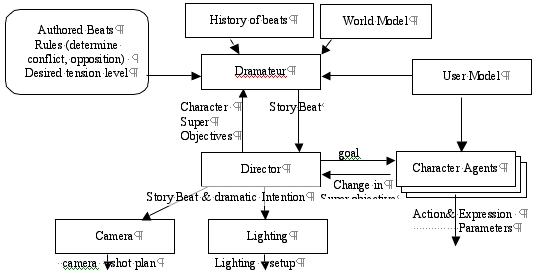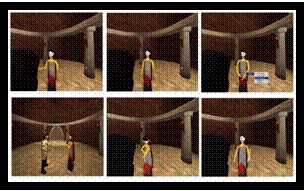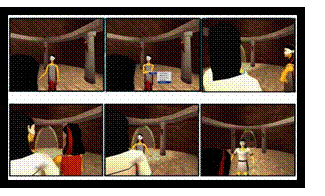Abstract
Heightening tension and drama in 3D interactive environments is a hard, but important problem. It is important for its potential utility in increasing motivation, involvement, engagement, and providing an overall pleasing aesthetic experience. These constructs are not only useful for entertainment applications, but can also impact training and edutainment applications due to the impact of emotions on learning. To stimulate emotional engagement, many researchers have explored several techniques, including enhancing the story content, developing new algorithms for dynamically creating stunning visual effects, and enhancing 3D sound. In this paper, I describe a set of new design techniques based on a study of film and theatre theories, including acting and screenwriting. These design techniques are integrated within a multi-agent interactive drama architecture. In this paper, I will discuss this architecture elaborating on the implementation of the theories studied and discussed from film and performance arts.
Introduction
Heightening tension and drama in 3-D environments is imperative. The impact of such enhancement is unquestionable for the entertainment industry, but is also significant for applications such as training, educational games, and therapy. Enhancing emotional content in interactive 3D environments is a large topic involving research in areas such as story construction, graphics, environment design, input devices, voice synthesis, and interactive music; examples include. [1]
For several years, the game industry have held panels at the Game Developers Conference, talks [2], and published books [3] on the topic of emotional engagement and games. However, the problem still persists. The interaction models used in games are very limited, which restricts the evoked emotions to basic emotions, such as fear, anticipation, and frustration. In addition, game developers often use static techniques directly adopted from cinematic theory, such as narrative structures. [4] These static techniques frustrate users and usually do not evoke the desired emotional responses unless the user abides by the designed structure. In games today, drama and conflict is scripted and often feels 'plastic.' Most of the techniques currently used do not sufficiently create conflict or drama within the player.
Few research groups have attempted to develop techniques for enhancing emotional engagement. For example, Young proposed a plan-based interactive narrative architecture, where plans are revised depending on users' actions, thus enhancing the adaptability of the story to user's actions. [5] This, however, does not necessitate a dramatic experience. Peter Weyhrauch proposed an interactive drama manager that uses game theory to select a story event given the current story state, thus sustaining drama and conflict. [6] Andrew Stern and Michael Mateas developed an interactive story based in a domestic drama. [7]
After careful analysis of screenwriting and acting techniques, I realized that previous work lacks a formal model that interjects design techniques used in film and theatre to evoke and sustain drama. In an effort to expand on previous work, we have extended previous work's implementations to include design methods that evoke and sustain drama using screenwriting and acting theories. In this paper, I present these design techniques collected from acting and screenwriting theories. I will also describe a simplified implementation of these design techniques in a multi-agent architecture.
Lessons from the Performance Arts
Dramatic Arc
In a typical film or a play, the drama escalates to a peak (the crisis point) then it is released. The shape of dramatic tension through time can be visualized as an arc (called dramatic arc). [13] The arc is not monotonic. The play or film is typically composed of scenes and scenes are composed of beats (the word beat here defines the small unit of action that has its own complete shape with a goal and an action), each has its own arc with a turning point where tension reaches its maximum point after which tension is released. [8]
The Ticking Clock
The concept of the ticking clock has been used as a dramatic device in many performances. It defines several techniques, including dialogue, visual hints, or projections of possible future outcomes or events. Examples include the clock reaching 6:00p in the Saw or the train arriving at noon with the bad guy on it in High Noon. This kind of instrument can be very effective in creating anticipation.
Acting -- defining tactics and beats
In performing a character, the actor needs to define his/her character's super objectives (goals) and tactics throughout the story. Character tactics define the set of behaviours that a character undertakes to achieve his/her needs. Within each story beat, the character chooses a goal and a tactic. He/she continuously monitors the other characters' behaviours evaluating the success or failure of the chosen tactic. [9] Analyzing character action according to goals and tactics gives characters direction and consistency. In addition, using tactics and constant fee dback to evaluate tactics is an important method for achieving a more believable character.
Defining Actor's goals
One important rule that Bruder describes is: actors should choose goals or tactics for their characters, such that the goal (a) includes the other character(s) in the scene, and (b) is in conflict with other character(s) on stage. [10] This is essential to create and sustain conflict in the scene. I found this rule to be very effective in acting and improv classes. It encouraged involvement and increased emotional engagement.
This technique can also be used in an interactive environment by rewriting the rule to: at least one character in the scene should choose a goal/tactic that includes and is in opposition to the user. This creates conflict and sustains the drama as defined in relation to the user. It also enforces a user centric architecture.
Architecture

Figure 1: System Architecture
Due to space restrictions, I will not discuss this architecture in detail, but rather summarize the components and outline the implementation of the design techniques discussed in the previous section. The architecture is outlined in figure 1. It is composed of several agents: dramateur, character agents, a director agent, a lighting agent, a camera agent, and a user model which is continuously refined as the interactive experience progresses. The dramateur agent, similar to the work of Mateas and Stern [11] is responsible for selecting a story event to execute based on a set of authored story actions, user model, characters in the scene, and story history. It also accounts for the level of conflict and tension in the situation when selecting a story action to fire. Given a selected story action, the director agent allocates sub-goals to the different characters in the scene. Depending on the current situation and the user model, these characters then choose tactics that can achieve the goals suggested by the director agent. The character agents continuously monitor user's actions and the situation evaluating the level of success or failure of their tactics. If a tactic fails, another tactic is selected, and so on. Depending on the tactics, the tension level, context, and the success and failure of other tactics, character agents select an action and use adverbs to selectively tune the action to express an emotion.
Preserving dramatic arc
The dramateur agent takes several constraints and elements into account when selecting a story beat to fire. One of these elements is the dramatic intensity. To preserve the dramatic arc, the dramateur increases, or decreases given the current tension level by firing appropriate events at the right time.
This requires evaluating the beats and determining how they influence the current situation. This is a hard problem to au tomate, since information about context, meaning, and common sense will need to be encoded. Instead, the architecture is designed to allow authors to write rules identifying shifts in dramatic tension through beat changes. These rules allow the dramateur to compute increase and decrease of the dramatic intensity given a specific beat pattern and context information (e.g., relationship values), e.g.:
if beat#2 is followed by beat #5
and Electra is using the threatening tactic on the user
then increase dramatic intensity by 10 increments.
Ticking Clock
This concept can be implemented in several ways. First approach is to design it or hard code it within the system. The other is to allow designers to provide alternative clocks depending on story context, and develop a system that adopts the appropriate clock and thus shows specific events related to the clock at different instances in the interactive experience. The first approach is easy, but may result in linear play. The second approach is difficult, and would require much content development from the designer. I implemented the first approach.
Selecting character goals to emphasis conflict and drama
When selecting character goals or story events the dramateur agent, director agent, and the character agents use a predicted user model that identifies user's possible intension and goals based on his/her actions. Based on these goals and intensions the agents can then choose events, character goals and tactics that is in opposition of the user's goals and thus enhance the drama and conflict.
Inferring user intentions or goals is a hard problem although some solutions exist. [12] For interactive narrative, the problem is simpler because the narrative provides a context that can be used to infer the goals. Thus, I use some rules that estimate user's goals based on story context. The story context is symbolically represented based on scene configuration, tension level, and the history of beats executed.
I presented to user model as a vector: <hero, violent, self-interested, coward, and truth-seeker>. Given a user action, the history of user actions, and the story context, a rule-based system is used to modify the user model reflecting the user's choice. The system uses very simple rules, such as 'if user advances to attack unarmed characters then advance user on the violence scale.' The architecture includes a language that authors can use to write rules for more complicated inference involving behavioral patterns and character relationships. The system also calculates a confidence measure of its current user character estimate. This measure is defined as a function of (i) the time it took the user to make a choice and (ii) the conformance to the estimated pattern given the predicted user character, which was simply calculated as the max of the vector above.
Preserving character tactics and beats
The character agent is equipped with the ability to dynamically adapt to the user's behaviours using a predicted user goal and intention. Agents continuously monitor mouse movements and mouse clicks for clues to infer the direction of user's attention and user's goals and intentions. Given these inferred values, the agent will continuously adjust its success or failure rates until failure reaches the tolerance limit. If failure occurs, the character will (1) declare the tactic a failure, (2) update the user model, and (3) choose another tactic to solve the character-goal.
Implementation and Results
Below I discuss several scenes from Mirage showing the adaptability of agent's behaviours to user's goals. The architecture was a product of iterative design. As described above, the plot varies in response to the estimated user stereotype. To fully appreciate the interactive narrative system, readers need to interact with the system. In order to show variations in the plot, I will use screenshots.
 
Figure 2: Showing outcome when user as truth seeker type
Figure 3: Showing dynamic change of tactic within the
(character choice: truth seeker) interactive story (character choice: coward)
Figures 2 and 3 show several screenshots from Mirage. The figures show two characters: Electra and Archemedis. Archemedis is under the control of the user. Electra is an agent; she selects behaviours to achieve the character goals given to her by the director agent. The camera and lighting agents also play a role in choosing positions and orientations to show and support the narrative. In this scene, Electra is trying to convince the user to help her kill the king and queen. The figures 2 and 3 show two variations depicting two different user characters. In figure 2 Electra, realizing that the user is the truth seeker type as inferred by the history of his actions, reverts to violence to achieve her goal. Figure 3, on the other hand, shows some exchange where Electra realizes that the user is the coward type and is leaving, she quickly reverts to blocking his way and telling him that he may have the disease too and he needs to kill his parents to save himself. Therefore, she used his cowardice to get to her goal.
Conclusion
In conclusion, I have presented several design techniques adapted from acting and screenwriting theories. My focus was to discuss such design techniques and their implication in enhancing the aesthetic experience within interactive 3-D environments. It is hard to quantitatively evaluate such a system, but easier to evaluate its engagement value when interacting within it. According to the critiques and our (me and my collaborators) assessment of the system, I believe that the design techniques discussed in this paper can lead to a significantly better design for an interactive narrative increasing and enhancing emotional involvement and engagement. Such an architecture may have an impact on training, educational, entertainment applications. However, the road to proving such a claimis still long and requires many prototypes in different systems beyond what is presented here.
Magy Seif El-Nasr, Penn State University
References
[1] K. Madej, "Towards Digital Narrative for Children: From Education to Entertainment: A Historical Prespective" in ACM Computers in Entertainment , 1 (1).
J.F. Morie, K. Iyer, K. Valanejad, R. Sadek, D. Miraglia, D. Milam, "Emotionally Evocative Environments for Training" in Army Science Conference, 2002
[2] B. Kane, Postcard fromGDC 2003: 34 Ways to Put Emotions Into Games Gamasutra, 2003.
N. Lazzaro, "Why We Play Games Together: The People Factor" in Game Developers Conference, San Francisco, 2005
[3] D. Freeman, Creating Emotions in Games (New Riders, 2003)
[4] D. Freeman, Creating Emotions in Games (New Riders, 2003)
R. McKee, Story: Substance, Structure, Style, and the Principles of Screenwriting (HarperCollins: New York, 1997)
[5] M. Young, "Notes on the use of plan structures in the creation of interactive plot" in AAAI Fall Symposium on Narrative Intelligence, MA, 2000
[6] P. Weyhrauch, Guiding Interactive Drama (Carnegie Mellon University: Pittsburgh, 1997)
[7] M. Mateas, A. Stern, "Towards Integrating Plot and Character for Interactive Drama" in Socially Intelligent Agents: The Human in the Loop AAAI Fall Symposium, 2000.
[8] R. Benedetti, Actor at Work (Prentice-Hall: Englewood Cliffs, 1994)
[9] Ibid. [8]
[10] M. Bruder, A Practical Handbook for the Actor (Vintage: 1986)
[11] M. Mateas, A. Stern, "Interactive Drama - A Thesis Proposal," Carnegie Mellon University, Pittsburgh, 2001.
M. Mateas, A. Stern, "Towards Integrating Plot and Character for Interactive Drama" in Socially Intelligent Agents: The Human in the Loop AAAI Fall Symposium, 2000
[12] H.A. Kautz, "A Formal Theory of Plan Recognition," Department of Computer Science, University of Manchester, 1987
M.E. Pollack, "A Model of Plan Inference that Distinguishes between the Beliefs of Actors and Observers" in 24th Annual Meeting of the Association for Computional Linguistics (1986), p. 207-214 |

